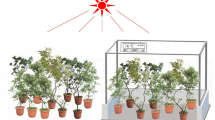Summary
Mixed stands of chaparral in California usually contain several species of shrubs growing close to each other so that aerial branches and subterranean roots overlap. There is some evidence that roots are stratified relative to depth. It may be that root stratification promotes sharing of soil moisture resources. We examined this possibility by comparing seasonal water use patterns in a mixed stand of chaparral dominated by four species of shrubs: Quercus durata, Heteromeles arbutifolia, Adenostoma fasciculatum, and Rhamnus californica. We used a neutron probe and soil phychrometers to follow seasonal depletion and recharging of soil moisture and compared these patterns to seasonal patterns of predawn water potentials, diurnal leaf conductances, and diurnal leaf water potentials. Our results indicated that 1) Quercus was deeply rooted, having high water potentials and high leaf conductances throughout the summer drought period, 2) Heteromeles/Adenostoma were intermediate in rooting depth, water potentials, and leaf conductances, and 3) Rhamnus was shallow rooted, having the lowest water potentials and leaf conductances. During the peak of the drought, predawn water potentials for Quercus corresponded to soil water potentials at or below a depth of 2 m, predawn water potentials of Heteromeles/ Adenostoma corresponded to a depth of 0.75 m, and predawn water potentials of Rhamnus corresponded to a depth of 0.5 m. This study supports the concept that co-occurring shrubs of chaparral in California utilize a different base of soil moisture resources.
Similar content being viewed by others
References
Aschmann H (1973) Distribution and peculiarity of mediterranean ecosystems. In: diCastri F, Mooney HA (eds) Mediterranean ecosystems: origin and structure. Springer, Berlin Heidelberg New York, pp 11–19
Burk JK (1978) Seasonal and diurnal water potentials in selected chaparral shrubs. Am Midl Nat 99:244–248
Cole HE, Holch AE (1941) The root habits of certain weeds of southeastern Kansas. Ecology 22:141–147
Cooper WS (1922) The broad sclerophyll vegetation of California. Carnegie Inst Wash Pub, p 122
Davis SD, Mooney HA (1985) Comparative water relations of adjacent California shrub and grassland communities. Oecologia (Berlin) 66:522–529
Davis SD, Mooney HA (1986) Tissue water relations of four cooccurring chaparral shrubs. Oecologia (Berlin) (in press)
Hellmers H, Horton JS, Juhren G, O'Keefe J (1955) Root systems of some chaparral plants in southern California. Ecology 36:667–678
Kummerow J, Krause D, Jow W (1977) Root systems of chaparral shrubs. Oecologia (Berlin) 29:163–177
Kummerow J, Mangan R (1981) Root systems in Quercus dumosa Nutt. dominate chaparral in southern California. Acta Oecologia Plant 2:177–188
Mooney HA (1981) Primary production in mediterranean-climate regions. In: diCastri F, Goodall DW, Specht RL (eds) Mediterranean-type shrublands. Elsevier, Amsterdam, pp 249–255
Mooney HA, Harrison AT, Morrow PA (1975) Environmental limitations of photosynthesis on a California evergreen shrub. Oecologia (Berlin) 19:293–301
Munz PA (1974) A flora of southern California. Univ Calif Press, Berkeley, p 1086
Page BM, Tabor LL (1967) Chaotic structure and Decollement in cenozoic rocks near Stanford University, California. Geol Soc Am Bull 78:1–12
Poole DK, Miller PC (1975) Water relations of selected species of chaparral and coastal sage communities. Ecology 56:1118–1128
Rowe PB, Reimann LF (1961) Water use by brush, grass, and grass-forb vegetation. J Forestry 59:175–181
Scholander PF, Hammel HT, Bradstreet ED, Hemmingsen HA (1965) Sap pressure in vascular plants. Science 148:339–346
Weaver JE, Darland RW (1949) Soil-root relationships of certain native grasses in various soil types. Ecol Monogr 19:303–338
Wieland NK, Bazzaz FA (1975) Physiological ecology of three codominant successional annuals. Ecology 56:681–688
Williams WE (1983) Optimal water-use efficiency in a California shrub. Plant, Cell and Environ 6:145–151
Author information
Authors and Affiliations
Rights and permissions
About this article
Cite this article
Davis, S.D., Mooney, H.A. Water use patterns of four co-occurring chaparral shrubs. Oecologia 70, 172–177 (1986). https://doi.org/10.1007/BF00379236
Received:
Issue Date:
DOI: https://doi.org/10.1007/BF00379236




